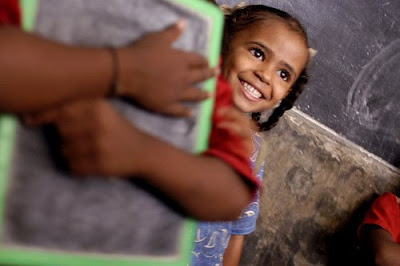The State of Indian Education

 The figures from two surveys conducted in 1996 and 2006 reveal that a few positive changes have entered the field of education in India. The number of children enrolling in schools has increased and universal school participation could become a reality in the future. With social divides disappearing, better infrastructure being provided, increased number of incentives and school meals in place and the combined efforts of the government, organizations, communities and individuals, the stage is set. But then, what is going wrong?
The figures from two surveys conducted in 1996 and 2006 reveal that a few positive changes have entered the field of education in India. The number of children enrolling in schools has increased and universal school participation could become a reality in the future. With social divides disappearing, better infrastructure being provided, increased number of incentives and school meals in place and the combined efforts of the government, organizations, communities and individuals, the stage is set. But then, what is going wrong?In rural North India, about half of the time, there is no teaching going on in primary schools.This was one of the key findings of the “PROBE survey” conducted in 1996-97 in Hindi-speaking States. A resurvey conducted 10 years later (in 2006) found that nothing had changed in this respect – half of the government schools still had no teaching activity when the investigators arrived. Whatever else had changed, classroom-activity levels had not improved.
To begin with, enrolment does not mean attendance. Almost everywhere, we found that children’s attendance as noted in the school register was far below the enrolment.Even in functional schools, levels of teaching activity were abysmally low. One reason is the widespread shortage of teachers. Even though there was a major increase in the number of teachers appointed, the pupil-teacher ratio in the survey areas showed little improvement over the years.
The situation is aggravated by the fact that teachers are often absent, or come late and leave early.
Even in cases where teachers were present, they were not necessarily teaching.
Even in schools where teaching was going on, children were getting a raw deal. Mindless rote learning still dominated the classroom.
It is therefore not surprising that children learnt little in most schools. Even in terms of the elementary “3 Rs” (reading, writing and arithmetic), learning achievements were very poor. We found that 80 per cent of the children in Classes 4 or 5 could do simple addition and 60 per cent could do simple subtraction. However, when it came to even single digit multiplication, the proportion dropped to 55 per cent. And only half could do a simple division by 5. Further, a large proportion of children was unable to read and write, or answer simple questions, even after four or five years at school. For instance, nearly 62 per cent of children studying in Class 4 or 5 in a government school could not read a simple story. And more than 80 per cent could not write the answer to a simple question. Unfortunately, years of schooling and grades completed continue to remain an unreliable guide to what children learn and know.
The absence of any improvement in classroom activity is perhaps the most alarming aspect of this pattern. The need of the hour is to consolidate the momentum of positive change and extend it to new areas – particularly that of quality education. Restoring accountability in the schooling system is not a simple matter, but “where there is a will, there is a way”. The first step is to stop tolerating the gross injustice that is being done to Indian children today. Wasting their time day after day in idle classrooms is nothing short of a crime.
Read the entire article here.
Image Source: Pratham Books (photography by Ryan Lobo)






